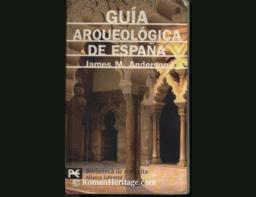RomanHeritage
is a non-profit cultural website about Ancient Rome, with Republican & Imperial Roman sites, roman ruins, Museums, books & movies, re-enactment groups, statues, Mosaics, frescoes, bronzes, etc.
Roman Heritage / Legado Romano
web sin ánimo de lucro sobre el Imperio romano, los yacimientos, ruinas romanas, museos, libros y películas, reconstrucción histórica, estatuas, mosaicos, frescos, etc.
Roman Heritage /Heredité Romaine
c'est une website sur l'empire Romain avec de Ruines romaines, museés, livres et films, groupes de reconstrucion historique, statues, mosaics et frescos.
Hispania España

Hispania
The Roman conquest of Hispania takes place as a reaction to the invasion of Italy on the part of the Carthaginian army of Aníbal, in order to cut the supply route of provision and its sources as much of men and of money. The official excuse that the Romans presented was the defense of Sagunto, a city allied with the Romans and which was conquered by Hannibal in 219 BC. Although the Romans take almost 9 years in re-conquering it, because of what they considered “casus belli”, a better understanding of a general expansive strategy rather than a particular defensive strategy.
The Senate decided to send the brother of Escipio, Cneo and their father Publio Cornelio that disembarked with the troops from the Greek colony of Ampurias, in the northeastern peninsula, in 218 BC. After different battles, both brothers die in Hispania, being sent the son of the second, Publio Cornelio Escipión’s son, nicknamed later Africanus, who moves quickly, lowering by all the Mediterranean coast, until Carthage Nova, or Cartagena, the capital of the Punic ones in Spain, that takes to the assault, with an audacious nigh raid. After defeating Asdrubal in the battle of Baecula, close to Castulo, en Jaen, they were displaced once again towards the West, obtaining a definitive victory in the battle of Ilipa against Magon, finally reaching Gades, the actual Cadiz in the Atalntic in 206 B.C., after having been defeated by the Carthaginians.
Next a process of progressive Romanisation of the different zones will be carried out iberas of the Bética, including/understanding the valley of the Guadalquivir and all the Andalusian coast, Murcian and levantino from step, to end up founding a city like Itálica for the veterans of this war.
But the Roman domination is not complete, producing some revolts in areas that were apparently conquered, the most notable being the one than ruthlessly crushed Cato the Elder at the beginning of the 2nd century.
The second phase of the conquest comes with the drive towards the interior of the Celtiberian wars of the 2nd century BC., with the introduction of the two plateaus, marking a series of military landmarks and cities, Segeda, Termancia (Tiermes), Oxma and, mainly, Numancia. On the internet on the web there is a guide you can follow and track the entire area the Roman’s conquered as the second chapter of their conquests, and the later splendor of the Roman cities, as in the case of Segóbriga, Clunia or Medinaceli. In addition to this fight against the Celts in the cities, there is a guerilla war instigated by the Lusitanian leader Viriato to keep in check several Roman legions for years until finally being betrayed.
The conquest was stopped for most of the 1st century BC by the Roman civil wars, first of Sertorio, that involves towns, cities and tribes from Calahorra and Pamplona to Cordova, through Azila in Aragon and Osuna in Seville, followed by the confrontations between Cesareans and Pompeii followers in Lleida and Munda. The last phase of the conquest came in the hand of Emperor Augustus in the Cantabrian wars, covering the north of the peninsula, against the Cantabrians and Asturiians.
After so much war, we considered it appropriate to present a time, supposedly “golden”, of “Pax Romana”. Having already presented Tarragona, Córdoba and Segóbriga, we had stopped at the jewels that Zaragoza and Mérida give us, which, along with Itálica represent the greatest monuments of Roman Art in Spain. In the same way, and with the excuse of Roman contributions, we have covered the mining, in Médulas or Jaén; the silver route from Astorga to Itálica, via Caparra, the production of fish paste called Garum (in Bolonia, Almuñecar or Carteia among others); the temples (especially those that contained vertical traces, from the reconstruction of Vic, to Barcelona, Merida, Évora, Cordova, Peraleda, etc.); and the funeral rites (from the road the mausoleums of Aragon, to necrópolis of Carmona, the columbarios, etc.); the water works (from aqueducts like those of Segovia, Tarragona or Merida), to other water related works, such as the dams or Muel Almonacid, (and the erroneously identified as Roman, as Proserpina, the Cornalbo, or smallest of Consuegra, which are all from a latter date) and other additional subjects.
Finally, with the advent of the Barbarians, we have presented the walled cities, using the example of Barcelona, Lugo and Coria, with traces in Leon, Gerona, Tarragona and others, but, above all, with the gradual abandonment of the cities, and an acceleration of the evolution towards the rural life has produced rural villas, like the Olmeda, Carranque, Almenara-Puras, Almedinillas, Centcelles, Noheda etc., with beautiful and outstanding polychrome mosaics.
I would like to recommend the "Diccionario de Hispania Romana" by Ph.D. Francisco Arroyo, where names of characters, places and monuments are presented in a very comprehensive way in its 875 pages, published by Editorial Aldebarán. With a totally different approach, you may consult the light "Atlas ilustrado de la España romana" by editorial Susaeta. Finally, the "Guía arqueológica de España", James M. Anderson, published by Alianza Editorial, which was one of my loyals companions in the several trips all over the country, and whose image I have chosen to illustrate this section.




